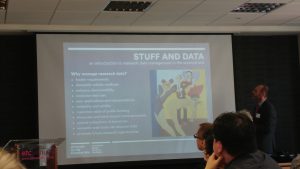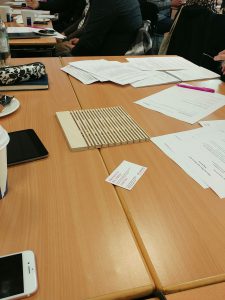A few weeks ago, UCA organised a workshop for all those interested in research data management in the creative arts. Amy Robinson reports back with a few takeaways and some useful links.
Exploring research data management in the creative arts
Booked up within a flash and oversubscribed, the Jisc-funded workshop, ‘Does my data look good in this?’, gathered 50 people to explore the nature of ‘research data’ in the creative arts, its importance, and what is needed for its curation and preservation to be effective.
 Run by the Centre for Digital Scholarship at the University for the Creative Arts, the workshop gave a unique opportunity to meet and share experiences with others who are working to support arts researchers with data management. The presentations, workshop activities and resources from the day can all be found online in the virtual good bag.
Run by the Centre for Digital Scholarship at the University for the Creative Arts, the workshop gave a unique opportunity to meet and share experiences with others who are working to support arts researchers with data management. The presentations, workshop activities and resources from the day can all be found online in the virtual good bag.
The day generated a huge amount of discussion and here are just a few of my own takeaways from the day:

- The use of real-life art and design objects (or ‘data’) proved a great way to kick-start discussion, using our university’s materials handling collection
- Arts data is heterogeneous and difficult to define, and arts researchers rarely think of their work in terms of ‘data’ and instead the word ‘stuff’ may resonate better
- Data management is important in our subject areas to show the value of the creative disciplines in the academic world
- Original data can also demonstrate the rationale for heritage decisions, for example, in the major restoration project for the Macintosh Library
- Social media such as Instagram is a modern day ‘cabinet of curiosities’ where arts researchers are collecting research data, and suits the peripatetic lifestyle of the arts researcher
- An arts repository is never ‘finished’, an up-to-date design is needed to engage researchers, along with a simple deposit process
- One idea for the future of RDM in the arts is the formation of a network or community of practice
Feedback and impact after the workshop
Starting out, participants had varying levels of understanding of creative arts data, but by the end of the workshop 92% said this had improved or greatly improved.
One participant has subsequently been inspired by the workshop to ‘kultur-ise’ their EPrints repository using the Kultur project plugin, and participants from two universities have been in contact with UCA about making use of our VADS4R data management training materials, specifically our examples of good and bad data management plans in the arts.
In their feedback, several attendees commented that it would be valuable to hold another event in say a year’s time to update on progress.
Want to know more? Join the Kultur list!
Workshop participants have also signed up to the dedicated discussion list for arts research deposit and data management at: Kultur@jiscmail.ac.uk
Please join this list if you would like to like to ask questions and share practice and advice in this specialised area!
Check out this storify from the event.
About the author: Amy Robinson has been working at UCA for over ten years specialising in digital curation. She manages the national VADS image collection for art and design, and the University’s Open Access research repository UCA Research Online, and has project managed a number of externally-funded projects relating to the creation, use, and management of digital assets in the visual arts, with a combined project funding of £370,000.

